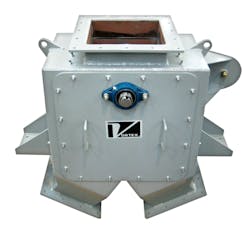When processors require material that is conveyed by gravity to be diverted from a single source to either of two destinations, they normally consider installing a flapper style diverter. This style of diverter has an internal blade that shifts back and forth to direct material to either destination. For many types of material, the flapper-style diverter is a perfect choice. However, when the material handled is larger or is highly abrasive, a pivoting chute diverter may be a better choice.
Design
Pivoting chute diverters are designed to offer uninterrupted flow of larger sized, abrasive materials (aggregates, minerals). Since there are no internal seals, this type diverter also addresses applications handling smaller sized, abrasive material (sand, limestone) that typically wears out the internal seals of a flapper diverter. The pivoting chute is used when some leakage of material to the off leg is not critical.
This carbon steel diverter houses an internal chute that diverts and directs material flow. The chute is constructed from abrasion-resistant metal, and may be lined with abrasion-resistant material, such as chromium carbide (optional), for added protection and longevity. Additionally, the "wetted parts" (material contact areas through the diverter) are constructed of or lined with abrasion-resistant material — depending on the application.
Advantages
A major advantage of pivoting chute diverters is the ability to "shift on the fly" as material is flowing through the diverter. With flapper style diverters, it is recommended that the material flow be shut off prior to shifting the blade to re-direct flow.
Pivoting chute diverter
Additionally, the pivoting chute allows material flow to be partially directed to two different destinations. This is extremely difficult to achieve with a flapper diverter because the flow to each leg will be diminished.
An exterior side access panel allows inspection, maintenance and repairs to be performed while the diverter remains in line — without having to remove it from service. The pivoting chute is available in both two-way and three-way configurations. Material within the diverter is dust-tight to atmosphere.
Selection considerations
Items to keep in mind when considering a pivoting chute diverter include:
- The stack-up height (flange to flange dimension) is slightly taller than a flapper-style diverter.
- There is possibility of material dusting to the opposite leg(s). In most abrasive material handling applications, these variables are not of major concern.
Kevin Peterson is the business development director for Vortex’s Titan Products line. Vortex Titan Valves are designed and engineered for applications that require larger sized valves or valves that address harsh abrasion from materials handled.

